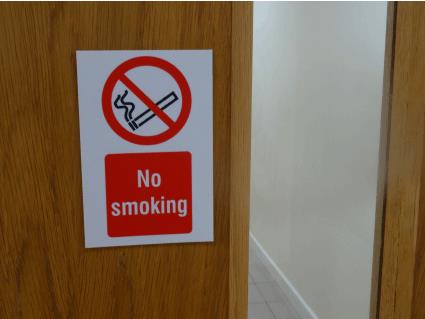
The no smoking debate and legislative battles around banning smoking in public areas is thought to be a modern construct, but funnily enough, this debate has run for over 500 years.
The first recorded example of smoking being banned came in 1575, where the Roman Catholic Church barred smoking tobacco in Mexican churches. In the UK, King James I signed an anti-smoking treatise in 1604, A Counterblaste to Tobacco, raising taxes on tobacco to prevent the rise of smoking. What is seen as a modern health and safety scare is, really, a battle that has been fought for hundreds of years.
However, the science behind the dangers of second-hand smoke in public places and the workplace is much more recent. With the rise of advertisement and tobacco lobbyists in the early twentieth century, the dangers behind smoking were concealed for many years. Nowadays, in Britain, smoking is banned in all public workspaces, as a consequence of several laws: Health & Social Care (Scotland) Act 2005, The Smoking (Northern Ireland) Order 2006, Smoke-free premises (Wales) Regulations 2007, and 2006 Health Act for England. But why is smoking banned in these spaces and why are no smoking signs so important?
The Dangers behind Second-Hand Smoke
The research behind second-hand smoke suggests that it is more dangerous than direct smoking. Non-smokers exposed to second-hand smoke in the workplace see their risk of lung cancer increase by 16-19%.
Employers have been held liable for exposing workers to unnecessary second-hand smoke; exposing workers to this type of smoke puts their long-term health and your long-term finances at risk.
Thankfully, there is overwhelming proof that smoking signposting and segregation measures work. A report in September 2018 by the University of Stirling found that there has been a 97% reduction in second-hand smoke over the past 20 years in Scotland. This reduction is as a direct consequence of the smoking ban, which required much more diligent uses of the “No Smoking” sign than ever before.
This hasn’t been a long-term effect, either. Immediately following the ban in 2007, bar workers – those who were most likely to be exposed to second-hand smoke, saw an immediate decrease in respiratory-related illnesses. In a review commissioned by the Department of Health in 2011, a 27% decrease in these illnesses post-ban, were recorded.
In essence, if your workplace does not have clearly signposted “No Smoking” signs and a segregated smoking area, then you are putting workers at risk. If your business is a public place, then there is a significant risk of exposure to your customers. It is illegal and liable to a fine or loss of licence for your business.
The Law
The no smoking ban was introduced on July 1st 2007, making it illegal to smoke in all public enclosed or substantially enclosed spaces, areas and workplaces. This ban includes public transport, along with train station platforms.
In order to comply with the law, businesses must “display ‘no smoking’ signs in all workplaces and vehicles”. As a result, it is the business’s responsibility to ensure appropriate ‘No Smoking’ signs are put up, as well as signposting the designated smoking area, preferably away from any doors and windows.
Local councils are responsible for enforcing this law, usually dishing out fixed penalties for those found breaking the ban. These bans extend to both the individual and the business:
- Businesses can be fined up to £2,500 for not preventing people from smoking or up to £1,000 if they don’t display appropriate No Smoking signs.
- Managers are responsible for smoke-related incidents on the premises.
- Individuals and workers can be fined up to £200 for not adhering to the ban.
Where to Place a No Smoking Sign
The law is pretty clear-cut on where to place a No Smoking sign. Following the Smoke-free (Signs) Regulations legislation of 2012, at least one legible “No Smoking” sign must be displayed in public premises, workplaces and vehicles.
However, it is up to the business to ensure these signs are placed in the right places. Generally, businesses will need more than one No Smoking sign up and fit specific specifications. Typically, signs must follow these specifications:
- At least the same size as an A5 piece of paper (21cm x 14.8cm)
- Must have the internationally-recognised No Smoking symbol in the centre, complete with the red circle and bar.
- The text “[no] smoking in this premises” must be somewhere on the sign. “Premises” can be replaced for the name of the premises in question (bar, café, factory, etc.)
In addition to the above, businesses are encouraged to have a smoking area clearly labelled with a “Smoking is permitted” sign, ensuring any on-site smoking occurs in this area.
Smaller secondary signs may be used to supplement this main one, too, but the minimum specifications can be easily met by our range of No Smoking signs at Label Source.
Label Source has a 25-year pedigree in the industry, alongside our No Smoking signs, be sure to check out our extensive range of warning signs and follow us on Facebook and Twitter to keep up with the latest health and safety news.